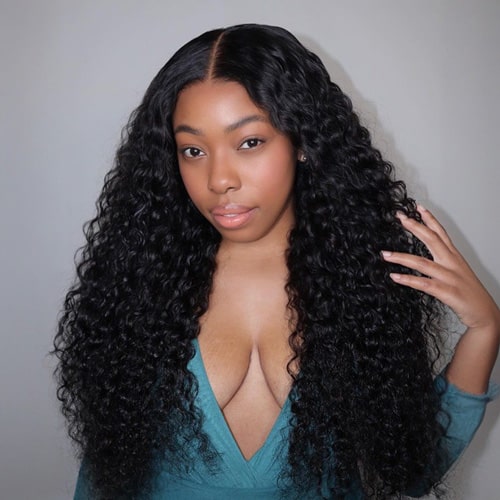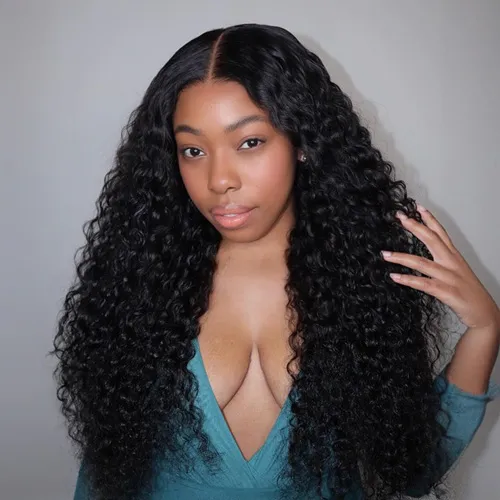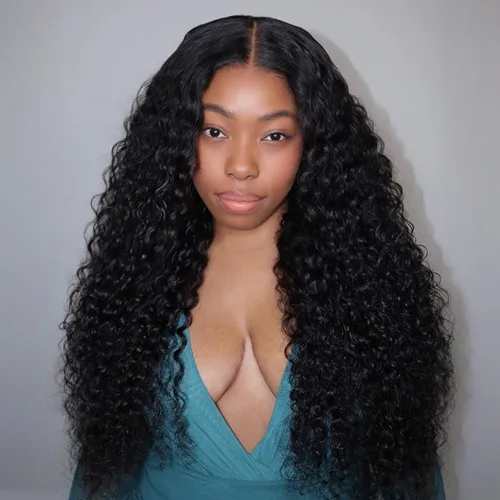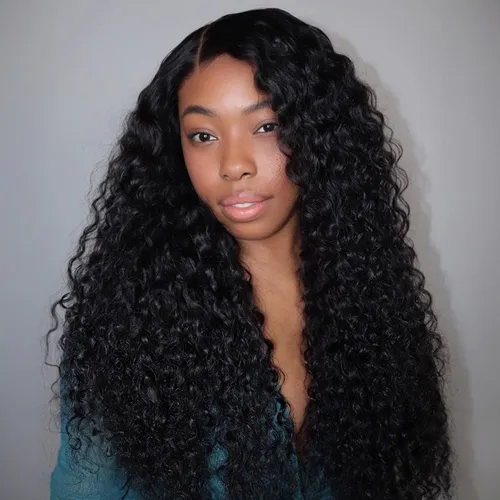Wade In: Everything You Need to Know About Water Wave Wigs

Whether you’re a seasoned wig enthusiast or a curious newcomer, understanding the nuances of water wave wigs can enhance your style repertoire and help you make waves wherever you go. This guide will delve into everything you need to know about water wave wigs, from their distinctive features and benefits to styling tips and maintenance advice, ensuring you’re well-equipped to make a splash with your new look.

Get the right wig.
Choosing the right water wave wig involves navigating through a myriad of options and pinpointing the one that best suits your lifestyle, aesthetic preferences, and budget. This decision can significantly influence how natural your wig looks and feels, as well as how well it integrates with your natural hairline and scalp. Below, we detail a comprehensive approach to selecting the perfect water wave wig, covering aspects from hair type and cap construction to density and color.
1. Human hair vs. Synthetic: Weighing the pros and cons.
The first decision you’ll encounter is choosing between human hair and synthetic fibers.
Human hair wigs offer unparalleled realism and versatility. They can be styled, dyed, and treated just like your own hair. While they require more maintenance, their lifespan is longer with proper care. They’re ideal for those seeking a high degree of authenticity and flexibility in styling.
Synthetic wigs have come a long way in mimicking the texture and appearance of natural hair. They offer the convenience of “shake-and-go” styles that retain their shape and texture through various conditions. They’re less prone to damage from the elements but generally offer less styling versatility, especially when it comes to heat styling. Synthetic wigs are budget-friendly and require minimal upkeep.
2. Understanding cap construction.
The cap is the base of the wig onto which hair is attached, and its construction affects the wig’s appearance, comfort, and styling options.
Lace front wigs feature a piece of lace at the hairline, where individual hair strands are tied, creating a natural-looking hairline. They allow for styling hair away from the face and are excellent for those seeking a realistic frontal appearance.
360 lace wigs offer a cap entirely made of lace, with each hair hand-tied onto the lace. This construction provides the most natural look, allowing for versatile styling, including ponytails and updos.
Monofilament caps mimic the look of the natural scalp where the hair is parted. They’re particularly good for those who demand a realistic parting area.
Basic caps are the most affordable option, with wefts of hair sewn onto the cap. They’re less natural-looking and offer limited styling flexibility but are lightweight and often more comfortable.
3. Selecting the right length and density.
Water wave wigs come in various lengths and densities, affecting the wig’s overall look and feel.
Length: Consider your lifestyle and the amount of maintenance you’re willing to commit to. Longer wigs offer versatility in styling but require more care to prevent tangling.
Density: Refers to how thick or thin the hair on the wig will be. A higher density means more hair and a fuller look, which can be great for achieving volume. However, a natural density is easier to manage and might feel more comfortable for daily wear.
4. Choosing the perfect color.
While some might prefer natural hair colors for a seamless blend with their scalp and natural hair, others might see wigs as an opportunity to experiment with colors and highlights without committing to permanent changes. When selecting a color:
For a natural look: Match the wig color to your natural hair color or choose a shade close to it. Consider your skin tone and which hair colors complement it best.
For experimentation: Don’t shy away from bold colors or highlights. Water wave wigs in vibrant colors can make a fashion statement and allow you to experiment with looks that you might not be willing to try with your natural hair.
5. Consider your lifestyle.
Your daily activities and the amount of time you can dedicate to wig maintenance should influence your choice. If you lead a busy lifestyle or have a rigorous exercise routine, consider a synthetic wig for its ease of care. If you enjoy styling your hair in various ways and have time for maintenance, a human hair wig might be more suitable.
6. Reputable brands and retailers.
Purchasing from reputable brands and retailers ensures that you receive a high-quality product that matches its description. Look for sellers with positive reviews and transparent return policies. It’s also beneficial to seek advice from wig communities and forums for recommendations based on your specific needs and desires.

Maintenance tips.
Maintaining a water wave wig properly is crucial for preserving its beauty, texture, and lifespan. Whether you’ve invested in a synthetic or human hair wig, following a dedicated maintenance routine will ensure your wig remains as vibrant and lively as the day you bought it. Here are tips to help you care for your water wave wig effectively:
1. General maintenance tips.
a. Wig washing Frequency:
Wash your wig every 2 to 4 weeks or after about 10 wears. Overwashing can lead to wear and tear, but underwashing can accumulate scalp oils and product buildup.
b. Procedure:
Use lukewarm water and a sulfate-free shampoo. For human hair wigs, condition after shampooing. Avoid scrubbing; instead, gently swish the wig in the water. Rinse thoroughly.
c. Drying:
Avoid wringing out your wig. Pat it gently with a towel to remove excess water.
Lay it on a towel to air dry or use a wig stand. Avoid direct sunlight or heat sources. For synthetic wigs, avoid blow dryers unless they are specifically heat-resistant.
d. Detangling:
Gently brush your wig with a wide-tooth comb or a wig brush, starting from the ends and working your way up to the roots to minimize shedding and breakage.
2. Human hair wig specifics.
a. Styling:
Use heat protectant sprays before using hot tools. Opt for ceramic or tourmaline irons and dryers as they distribute heat more evenly and minimize damage.
b. Deep conditioning:
Regularly deep condition your human hair wig to keep it hydrated and minimize frizz. Follow product instructions for the best results.
c. Coloring and perming:
Seek professional help for coloring or perming your wig to avoid damaging the hair. Remember, these chemical processes can shorten your wig’s lifespan.
3. Synthetic wig specifics.
a. Styling:
Avoid high heat. If your wig is heat-friendly, use the lowest settings. For non-heat-resistant wigs, use steam or hot water methods for curling or straightening.
b. Storage:
Keep synthetic wigs on a wig stand or mannequin head to maintain their shape. Using a hairnet can help prevent tangling and dust accumulation.
4. Both human hair and synthetic wigs.
a. Storage:
Store your wig on a wig stand or a mannequin head to preserve its shape and style. Ensure it’s kept away from direct sunlight to prevent color fading.
For long-term storage, place it in a silk or satin bag to protect it from dust and friction.
b. Avoiding tangles:
For water wave textures, use a detangling spray or leave-in conditioner to help manage tangles. Be gentle to prevent pulling out fibers or hair.
c. Handling shedding:
Some shedding is normal, especially after washing or brushing. Minimize shedding by detangling gently and avoiding unnecessary friction.
d. Lifestyle considerations:
Consider wearing a cap under your wig if you lead an active lifestyle or in hot climates to absorb excess sweat and oils.
When swimming, protect your wig from chlorine and saltwater by wearing a swim cap or tying it up to prevent tangling and damage.

FAQ about water wave wigs.
1. What is a water wave wig?
A water wave wig features a specific type of curl pattern that mimics the natural wave of water, providing a unique blend of volume, texture, and fluidity. This wig style is known for its loose, luxurious waves that offer a natural and versatile look.
2. How often should I wash my water wave wig?
It’s recommended to wash your water wave wig every 2 to 4 weeks or after about 10 wears. This frequency can vary based on how often the wig is worn, the amount of product used, and personal preference. Avoid overwashing to prevent drying out the hair.
3. Can I style my water wave wig with heat tools?
Human Hair Wigs: Yes, you can use heat tools on human hair wigs. Use a heat protectant spray and set your tools on a low to medium setting to prevent heat damage.
Synthetic Wigs: Heat-friendly synthetic wigs can be styled with low heat. Non-heat-resistant synthetic wigs should not be styled with heat tools as this can cause irreversible damage.
4. How do I prevent my water wave wig from tangling?
Use a wide-tooth comb or your fingers to gently detangle the wig starting from the ends and working your way up to the roots. Using a detangling spray or leave-in conditioner can also help reduce tangling and make the hair easier to manage.
5. What’s the best way to store my water wave wig when I’m not wearing it?
Store your wig on a wig stand or mannequin head to maintain its shape. If you’re storing it for an extended period, place it in a silk or satin bag to protect it from dust and friction. Avoid storing it in direct sunlight to prevent color fading.
6. Can I dye my water wave wig?
Human Hair Wigs: Yes, you can dye human hair wigs, but it’s recommended to have it done professionally to avoid damaging the hair.
Synthetic Wigs: Dyeing synthetic wigs is not recommended as the fiber does not react well to most dyes. Specialized synthetic-safe dyes are required, and results can vary.
7. What’s the difference between a water wave wig and a deep wave wig?
Water wave wigs have a looser curl pattern that mimics the look of water waves, offering a more relaxed and natural wave. Deep wave wigs have tighter, more defined curls that provide a fuller and more voluminous look.
8. Can I swim with my water wave wig?
Swimming with your wig is not recommended as chlorine and saltwater can damage the hair. If you must swim, wear a swim cap to protect the wig, or ensure you wash and condition it immediately after swimming.
9. How long can a water wave wig last?
Human Hair Wigs: With proper care, human hair wigs can last a year or more.
Synthetic Wigs: Synthetic wigs typically last 4 to 6 months with regular wear and proper maintenance.
10. How do I choose the right cap size for my water wave wig?
Measure your head according to the manufacturer’s guidelines to determine your size. Most wigs come with adjustable straps or bands that can help achieve a snug fit. Choosing the right cap size ensures comfort and a natural look.
11. Can water wave wigs look natural?
Yes, with the right care, styling, and cap construction (such as lace front or full lace caps), water wave wigs can look incredibly natural and mimic the appearance of real hair growing from your scalp.
12. Are water wave wigs suitable for all face shapes?
Yes, the versatility and natural flow of water wave wigs make them suitable for all face shapes. The key is to choose the right length and volume that complements your facial features and personal style preferences.
